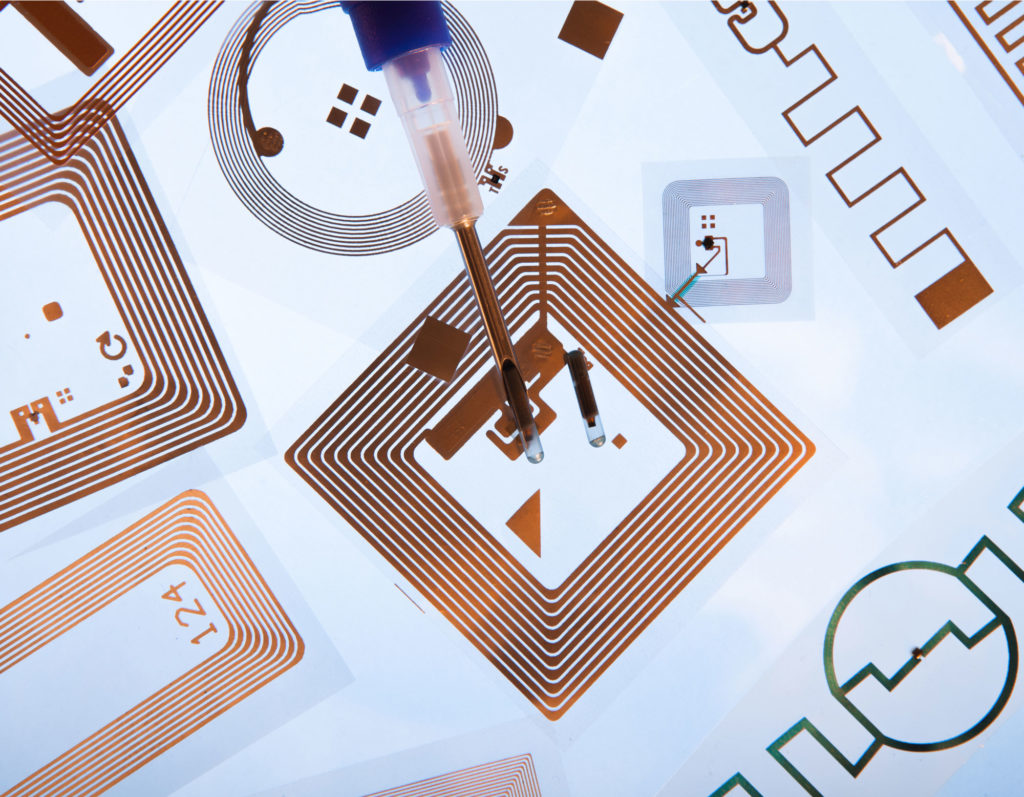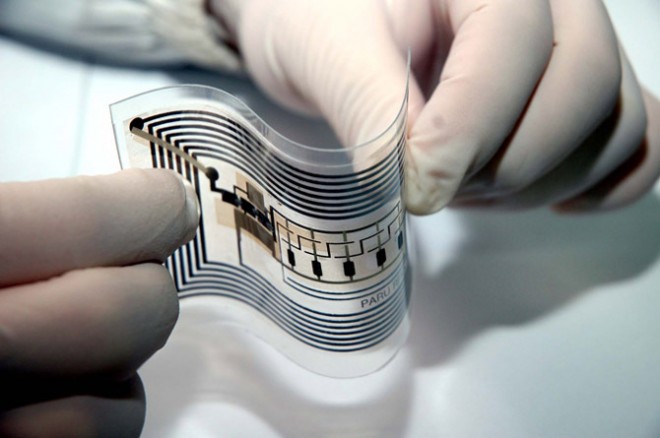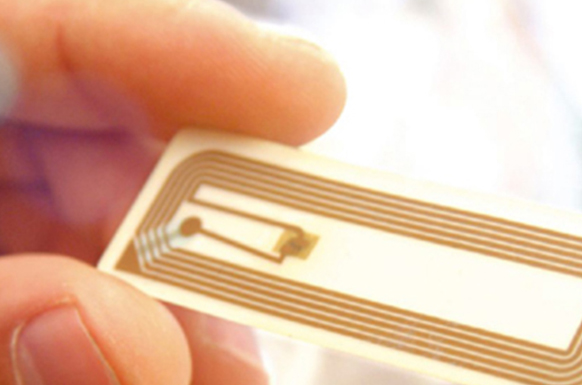RFID - How to use

It's in the keycard you wave to enter a secure office building. It's in the key fob you use to speed your gas purchases and the devices that let you zip through toll lanes on the highway.
You might not have heard of radio frequency identification, or RFID, but you probably encounter it every day. And it could be a valuable tool for your business.
 RFID is an automatic identification technology "• like a souped-up barcode. A barcode relies on a visual scan to transmit data, but RFID relies on radio waves and doesn't need a line-of-sight to read data. In place of a barcode, you have an RFID tag or "transponder," read by a hand-held reader, door-mounted reader, or some other configuration.
RFID is an automatic identification technology "• like a souped-up barcode. A barcode relies on a visual scan to transmit data, but RFID relies on radio waves and doesn't need a line-of-sight to read data. In place of a barcode, you have an RFID tag or "transponder," read by a hand-held reader, door-mounted reader, or some other configuration.
Many large companies and organizations have adapted RFID to business applications, such as supply chain logistics. The U.S. Department of Defense, Wal-Mart and Sam's Club, along with some other retailers, now require that their suppliers tag shipments with RFID so that the data can be automatically recorded when goods arrive. But because many of the companies that supply the DoD and the retail chains are small and mid-sized businesses, and because RFID has more business uses, RFID is a technology tool with which businesses of all sizes may need to become familiar.
"RFID has been used mainly by large companies so far, but there is nothing inherent in the technology that makes it a big company technology," says Mark Roberti, founder and editor of RFID Journal, an independent media company devoted to RFID and its many business applications. "RFID helps companies identify, monitor, and manage all the things in their business that they are not managing effectively today, which is just about everything that is mobile and not connected to the Internet. So if you are a small company that has containers, tools, vehicles, inventory, files, and so on, then RFID can help improve the way you do business."
The following guide details the types of small business applications of RFID, types of RFID, and how to work with experts to implement RFID solutions.
How to Use RFID Technology: RFID Applications for Small Business
In addition to the requirements from bigger companies, some small businesses want to use RFID because the technology can help them solve business problems. "RFID makes companies of all sizes more efficient by helping them track their inventory and equipment," says Chuck Thompson, vice president of sales for Rush Tracking Systems, an RFID software and services firm. "These efficiencies most commonly come in the form of less labor and better accuracy. Many of our business cases are built by eliminating manual scanning, error proofing processes, and eliminating the non-value added labor associated with correcting errors such as expediting, searching, cycle counting, and reconciliation.
Before you even consider types of RFID technology, identify the business challenges you are trying to solve and the business processes you could put in place if you had near perfect visibility to your inventory and assets. Common starting points are areas where there is a repetitive need for data entry done manually or with barcodes, Thompson says.
Some of the challenges that RFID can help businesses address include the following, says Thompson:
- Improved IT asset utilization by tracking servers, notebooks, or lab equipment.
- Improved document management by tracking the location, status, and chain of custody of legal documents.
- Rental and "check-out" situations, such as tools or at an equipment rental outlet.
- Reducing inventory by providing an accurate picture of existing inventory and eliminating the need for over-ordering "backup inventory."
- Improved inventory accuracy reduces the non value add labor required to cycle count to find and verify where certain items are.
- Eliminating repetitive data entry, such as situations in which shipments are tracked by hand on a clipboard only to be entered later into a computer database.
- Keeping tabs on high-value assets or products, for example, calibration equipment, construction tools, or medical devices.
- Tracking high-turnover products, like clothing in racks, hundreds of books at a bookstore, or tires on a rack.
- Tracking consigned inventory like eyeglasses at a doctor's office.
- Identifying and tracking returnable bins, racks, and containers like plastic totes, beer kegs, or gas cylinders at a medical supply house.
- And finally, in meeting customer mandates.
RFID can help companies manage many elements of their business that is not managed by their IT systems today, such as parts, tools, returnable containers, vehicles, and so on. "It can also help small manufacturers customize product for individual customers," Roberti says. "Customization increases the complexity of the supply chain, but RFID makes the process easier by providing accurate information about each item being tracked. The benefits that can be achieved are increased customer loyalty. That's a big one for many small companies."
Operationally, RFID can reduce costs associated with labor, time, and efficiencies "• such as automatically recording information about goods received into computer systems. But often small companies don't have large inventories to track, so a bigger benefit is reducing capital expenditure, Roberti says. "If you have tools, returnable containers, and other assets, you have to replace a certain amount of these each year," he says. "If you track these more effectively, you need fewer assets, which means you can reduce your annual capital expenditure."
How to Use RFID Technology: Types of RFID Technology
Before you hire a consultant or attempt to implement RFID on your own, you need some basic knowledge about the technology.
RFID Tags
RFID tags are available in three configurations:
- Passive tags have no internal power source, but they draw power from the reader. These are usually the most inexpensive tags and are often disposable.
- Active tags contain a battery used for transmitting and are usually more expensive but can often be reused.
- Semi-passive, a hybrid of passive and active, use a battery to operate the RFID chip, but communicate using power from the reader.
RFID Frequencies
RFID tags are also available in various frequencies. These include low frequency (LF), high frequency (HF), ultra-high frequency (UHF), and ultra-wide band (UWB). Typically, higher frequencies offer more bandwidth and data exchange, and a higher communication range, Thompson says. Likely, you'll need UHF, the "supply chain frequency," mandated by Wal-Mart, the DoD, and Sam's Club.
RFID Starter Kits
As complex as RFID may sound, "it isn't sorcery," Thompson says. Nor is it as expensive as it was a few years ago when Wal-Mart mandated RFID from 100 of its larger suppliers. Some suppliers initially balked, with estimates of up to $1 million for new RFID systems, but technology vendors soon responded with easy-to-implement and lower cost "starter kits" and "slap-and-ship" applications, which allowed small businesses to experiment with RFID and try one application at a time.
"Many RFID equipment providers will provide starter kits for as low as $2,500, including a reader and some tags," Thompson says. "For $25,000, many implementers will provide some kind of express ROI assessment or focused implementation, including one or two readers, some tags, installation, and support."
The best type of project for a small business to start with is one that is small, confined to one application (such as asset tracking), and in a "closed loop," which means within the four walls of your property. Businesses can always expand the applications or the types of goods tracked, and the data can be integrated into enterprise computer systems, but it's important to master the technology on a small scale before attempting a larger undertaking, experts say.
How to Use RFID Technology: Working with RFID Experts
RFID is a tool, much like a hammer or wrench. Some jobs you can do yourself, but other times you'll need to call in a "master craftsman," Thompson says.
"Companies will most likely need help, except for the simplest applications," Roberti says. "One problem they will face is getting experienced systems integrators to work with them. There are very few highly experienced integrators, and they tend to focus on bigger companies that can spend more. Getting a good integrator involved in a smaller project can be a challenge, but if the scope of the project is well defined and the small company understands the benefit it will get, then an integrator will take the work."
Look only for consultants with experience implementing RFID and all forms of automatic identification, including barcode. While RFID is one method of auto ID and data transfer, it will not necessarily be the right one for your business, Thompson says. A reputable consultant will have numerous clients and references, and ideally, one with a product or process similar to yours.
Here are some things to ask the RFID implementer you're considering working with:
- Understand your integrator's main business and make sure they are focused on RFID. Are they really a hardware vendor trying to upsell software or services? Are they really a barcode integrator trying to sell RFID? Are they really a software provider trying to sell integration and deployment services?
- It's about business results, not technology. Make sure your integrator can point to successful projects they have deployed which have delivered business results.
- Be clear about the help you require. If you need help with the business case, then make sure to choose an integrator who can help you up front, building the project justification, as well as deploying the solution.
- Résumés of the people who will work on your implementation. "Ask if they are employees or contractors," Thompson says. "Ensure your services contract specifically states what role the experienced resources will play. Be sure they will not just be assisting by phone."
- A presentation that will provide an overview of the RFID solutions developed for other customers. The implementer has signed nondisclosure agreements, so they can't tell you everything, Thompson says. However, the implementer should be able to describe what equipment was used, how it was integrated, what challenges were overcome, and the business results of the solution.
- RFID customer references. Then thoroughly verify them.
- On-site training. "Look for a consultant who can provide on-site training," Thompson says. "Off-site product classes are good, but hands-on training with your specific solution is far better."
- Names of RFID hardware manufacturers with which the implementer has experience. Then ask the RFID manufacturer for a reference, and whether the implementer is certified on that equipment, Thompson suggests.
